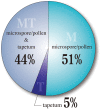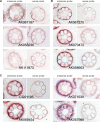Separated transcriptomes of male gametophyte and tapetum in rice: validity of a laser microdissection (LM) microarray
- PMID: 18755754
- PMCID: PMC2566930
- DOI: 10.1093/pcp/pcn124
Separated transcriptomes of male gametophyte and tapetum in rice: validity of a laser microdissection (LM) microarray
Abstract
In flowering plants, the male gametophyte, the pollen, develops in the anther. Complex patterns of gene expression in both the gametophytic and sporophytic tissues of the anther regulate this process. The gene expression profiles of the microspore/pollen and the sporophytic tapetum are of particular interest. In this study, a microarray technique combined with laser microdissection (44K LM-microarray) was developed and used to characterize separately the transcriptomes of the microspore/pollen and tapetum in rice. Expression profiles of 11 known tapetum specific-genes were consistent with previous reports. Based on their spatial and temporal expression patterns, 140 genes which had been previously defined as anther specific were further classified as male gametophyte specific (71 genes, 51%), tapetum-specific (seven genes, 5%) or expressed in both male gametophyte and tapetum (62 genes, 44%). These results indicate that the 44K LM-microarray is a reliable tool to analyze the gene expression profiles of two important cell types in the anther, the microspore/pollen and tapetum.
Figures






Similar articles
-
Various spatiotemporal expression profiles of anther-expressed genes in rice.Plant Cell Physiol. 2008 Oct;49(10):1417-28. doi: 10.1093/pcp/pcn128. Epub 2008 Sep 6. Plant Cell Physiol. 2008. PMID: 18776202 Free PMC article.
-
Comprehensive transcriptome analysis of phytohormone biosynthesis and signaling genes in microspore/pollen and tapetum of rice.Plant Cell Physiol. 2008 Oct;49(10):1429-50. doi: 10.1093/pcp/pcn123. Epub 2008 Aug 20. Plant Cell Physiol. 2008. PMID: 18718932 Free PMC article.
-
Comprehensive network analysis of anther-expressed genes in rice by the combination of 33 laser microdissection and 143 spatiotemporal microarrays.PLoS One. 2011;6(10):e26162. doi: 10.1371/journal.pone.0026162. Epub 2011 Oct 26. PLoS One. 2011. PMID: 22046259 Free PMC article.
-
Transcriptomes of the anther sporophyte: availability and uses.Plant Cell Physiol. 2011 Sep;52(9):1459-66. doi: 10.1093/pcp/pcr088. Epub 2011 Jul 9. Plant Cell Physiol. 2011. PMID: 21743085 Free PMC article. Review.
-
Rice anther tapetum: a vital reproductive cell layer for sporopollenin biosynthesis and pollen exine patterning.Plant Biol (Stuttg). 2023 Mar;25(2):233-245. doi: 10.1111/plb.13485. Epub 2022 Dec 16. Plant Biol (Stuttg). 2023. PMID: 36350096 Review.
Cited by
-
Expression dynamics of metabolic and regulatory components across stages of panicle and seed development in indica rice.Funct Integr Genomics. 2012 Jun;12(2):229-48. doi: 10.1007/s10142-012-0274-3. Epub 2012 Mar 31. Funct Integr Genomics. 2012. PMID: 22466020
-
Genome-wide identification and analysis of rice genes preferentially expressed in pollen at an early developmental stage.Plant Mol Biol. 2016 Sep;92(1-2):71-88. doi: 10.1007/s11103-016-0496-1. Epub 2016 Jun 29. Plant Mol Biol. 2016. PMID: 27356912
-
Identification of cis-elements and evaluation of upstream regulatory region of a rice anther-specific gene, OSIPP3, conferring pollen-specific expression in Oryza sativa (L.) ssp. indica.Plant Reprod. 2015 Dec;28(3-4):133-42. doi: 10.1007/s00497-015-0264-4. Epub 2015 Jun 17. Plant Reprod. 2015. PMID: 26081459
-
Pollen-specific expression of Oryza sativa indica pollen allergen gene (OSIPA) promoter in rice and Arabidopsis transgenic systems.Mol Biotechnol. 2011 May;48(1):49-59. doi: 10.1007/s12033-010-9347-5. Mol Biotechnol. 2011. PMID: 21061188
-
Cell type-specific transcriptome of Brassicaceae stigmatic papilla cells from a combination of laser microdissection and RNA sequencing.Plant Cell Physiol. 2013 Nov;54(11):1894-906. doi: 10.1093/pcp/pct133. Epub 2013 Sep 20. Plant Cell Physiol. 2013. PMID: 24058146 Free PMC article.
References
-
- Amagai M, Ariizumi T, Endo M, Hatakeyama K, Kuwata C, Shibata D, et al. Identification of anther-specific genes in a cruciferous model plant, Arabidopsis thaliana, by using a combination of Arabidopsis macroarray and mRNA derived from Brassica oleracea. Sex. Plant Reprod. 2003;15:213–222.
-
- Ariizumi T, Hatakeyama K, Hinata K, Inatsugi R, Nishida I, Sato S, et al. Disruption of the novel plant protein NEF1 affects lipid accumulation in the plastids of the tapetum and exine formation of pollen, resulting in male sterility in Arabidopsis thaliana. Plant J. 2004;39:170–1814. - PubMed
-
- Asano T, Masumura T, Kusano H, Kikuchi S, Kurita A, Shimada H, et al. Construction of a specialized cDNA library from plant cells isolated by laser capture microdissection: toward comprehensive analysis of the genes expressed in the rice phloem. Plant J. 2002;32:401–408. - PubMed
-
- Cai S, Lashbrook CC. Laser capture microdissection of plant cells from tape-transferred paraffin sections promotes recovery of structurally intact RNA for global gene profiling. Plant J. 2006;48:628–637. - PubMed
Publication types
MeSH terms
Substances
LinkOut - more resources
Full Text Sources

